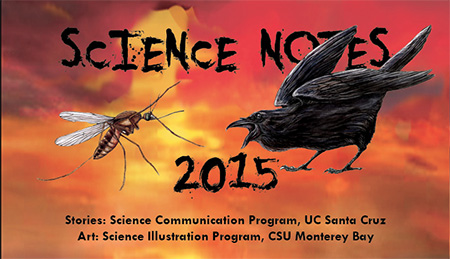Air pollution in Fresno that burrows into the lungs and cells of asthmatic children. A way to sharpen hearing aids by decoding the neural chatterings in zebra finch brains. The life, and painful death, of a condor named Ventana. These are among the offerings in Science Notes 2015, the annual multimedia magazine published by the UC Santa Cruz Science Communication Program.
The program's newest graduates welcome readers to dive into their features and multimedia packages. You'll read about the meanings of "clap-threat calls" by elephant seals, and you'll hear them in the podcast, too. A video describes climate change impacts on species across California, within a story about the margins of extinction for lizards and red-legged frogs. A state-by-state infographic traces West Nile virus infections, which the author follows from mosquitoes in Central Valley marshes to us -- by way of crows and robins.
You'll also see, smell, and feel the mystery of sea star wasting syndrome, join stroke survivors in a trial of virtual game-based movement therapy, and understand how our antiquated electrical grid isn't prepared for the solar panels popping up on your neighbors' roofs.
UC Santa Cruz faculty and researchers featured in the stories include biologists Barry Sinervo, Colleen Reichmuth, Caroline Casey, Marm Kilpatrick, and Peter Raimondi; computer engineers Luke Buschman, Sri Kurniawan, and Patrick Mantey; electrical engineer Joel Kubby; and environmental toxicologists Myra Finkelstein and Donald Smith.
As ever, Science Notes 2015 was a team effort, with illustrations provided by students in the Science Illustration Program at CSU Monterey Bay guided by director Ann Caudle and her lecturers. The sure hands of story consultant Gordy Slack and podcast instructor Molly Bentley are evident in each piece. Multimedia gurus Mary Miller (SciComm class of '90) and Lisa Strong ('93) guided the photography and videography. Graphics director Pai from the San Jose Mercury News advised students on their charts and maps.



